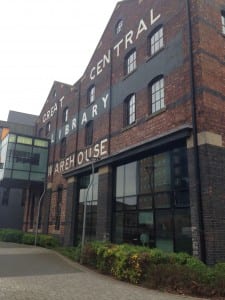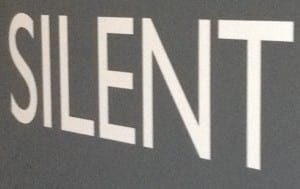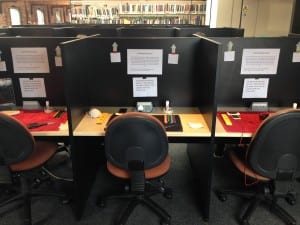Framing Statement
What is Site-Specific?
Site-Specific performance is creating and performing a piece of work that is not in the conventional theatre space. ‘A large part of the work has to do with researching a place, often an unusual one that is imbued with history or permeated with atmosphere’ (Pavis, 1998, 337-8). Pearson leads on from this explaining that ‘Any encounter with site is potentially divisive, recovering which was thought lost – reawakening memories, stirring emotions, mobilizing causes.’ (Pearson, 2010, 144). Site-Specific challenges the conventional theatre goers by changing the location and making it something new. Theatre is made to entertain and challenge which is also site-specific’s aim but, they are both located differently. Site-Specific brings locations to life that people would never have thought could have history or a story.
The Performance
On Friday 6th May 2016 DO YOU KNOW WHERE YOU ARE? Took audience members on a journey through the University of Lincoln Library formally known as the Great Central Warehouse. The piece was based on inviting audience members to go on a journey through the modern extension of the library back into the warehouse, made up of the original brick work from when it was first built in 1907, into a world of building and creation. The involvement of the audience was key for production to happen. They were to follow a trail with parts of the building being highlighted, before being lead into an immersive setting within the warehouse to build and create from materials provided to them. Following from Hill and Paris’s definition of “Live Art”:
‘Live Art practices have become more and more concerned with the specificity of their time and place, urging audience to consider what it means to be here, now, wherever and whenever now may be.’
(Hill and Paris, 2006, 12).
We focused on the history of the warehouse and taking people back through time. The intention being to make the audience question their whereabouts and place themselves into the shoes of who once walked the floors of the building. First starting at the barriers of the library the audience were to follow a trail of foot prints leading up the (modern extension) stairs towards the third floor of the library. When reaching the top floor a recording was ready to be played that had been slowed down and the volume raised to make it sound like a warehouse setting. They were in the present but we took them back to the past realising that, they were not where they thought they were. ‘Both inside and outside, the Great Central Warehouse retains much of its original ambiance’ (Riba, 2004) taking this into account we highlighted certain aspects of the building on the trail for the audience to notice and admire.

The warehouse is now a place of study with the modern extensions leading you back into the warehouse. The wide space that has now been filled with shelves and desks, this is what people would notice on a normal day to the warehouse. But on this journey the audience noticed what they didn’t know was there, for example, the original beams holding the building together with the original brick work creating the space. The unique wooden beams hold the roof above where the audience would be working like builders for roughly 20 minutes with a sound track played through headphones provided and the scenery there to help inspire their creations. The sculptures, once made by the audience participants were then given to myself, Ben and Jess to create an installation. The objective was to make the audience members work separately like builders would in a warehouse factory and hand over their component they have created to be shaped into something bigger. Showing them that although they built by themselves they still worked as a team to create something greater.
Analysis of Process
The Very First Idea
When creating a site-specific piece what needs to be considered is where you are, how you can use the space and what has already happened within the space. Once myself, Ben and Jess formed a group together we explored the space within the library, walking around and observing what we didn’t know was there before. For example, the steel and wooden beams of the library I personally had never really noticed. With this exercise in mind we started drafting ideas and researching. Coming across an article written by Wohl:
‘Harmon says […] without a compelling experimental component, one where the audience interfaces in unexpected and visceral ways with the contextual and empirical resonances of the site, they will lose interest…. the really successful site-based theatre productions are the ones that develop an immersive experience for the audience.’
(Wohl, 2004, 34-35)
With this in mind, we decided on an installation of a Magical Fortress made out of paper. ‘Installation artworks […] often occupy an entire room or gallery space that the spectator invariably has to walk through in order to engage fully with the work of art.’ (Tate, 2015). As a group we decided we didn’t want to perform but focus on doing an installation for the audience to walk into a new world. In the words of Oliveira et al in their book Installation Art in the New Millennium ‘Installation is therefore defined by this process, something that has led artists to work with materials and methodologies not traditionally associated with the visual arts.’ (Oliveira et al, 2003, 14). By reflecting on Oliveira et al we first considered what the library was made up of, which was books so we looked at The Book as Art for inspiration of what we could do with books. The intention from this idea was to transform a space into a magical fortress for anyone in the library to come and view to take them out of their working environment. We associated the idea with childhood memories of libraries. When you are a child, going to the library meant reading story books that took you to a new world and that’s what we wanted to reflect in this magical fortress. Unfortunately, once we pitched our idea, we were guided by our tutors that we had too many things going on at once and needed to simplify the idea. Also the history of the warehouse had not been mentioned or shown through the idea so we needed to consider how to incorporate the history into the performance.

(Crockford, 2016)
The Next Idea
The few ideas that we came up with we kept questioning ourselves: How does it relate to the warehouse and its history? In a session with our tutor he told us to use our senses, don’t always use our eyes but our other senses too. The senses are what we as people use on the daily so why not incorporate them into a performance. This is when we came across the idea of involving the audience in the performance using their senses. ‘Live Art questions assumptions and defies expectations about who an audience can be, what they might be interested in and the means by which they can be addresses.’ (Hill et al, 2006, 14). People are categorised dependant on what they are watching whether it’s television (a viewer), a theatre show (audience member) or a football game (spectator). In a session we had with our tutor we used members of the public’s reactions to spark out minds and creativity. At one point we stood in a group outside the library just looking up at a boy who had been observing us like a ‘spectator’. So we observed him as a ‘crowd’. By watching this boy do a daily task of just sitting and studying made me realise that in reality the simplest action in a performance can make it all the more interesting. With this as an influence and considering the senses and history we thought of two ideas and keeping it simple.
-
Create a room of collected sounds of the library and overlapping them to play in a room to show how noisy the library actually is.
-
Creating a room that smells, sounds and feels like a warehouse and making us the ‘spectators’.
Punchdrunk helped to influence this idea by their use of the audience’s senses. They place their audiences into situations of making them choose where they want to go in performance (promenade theatre) which actively stimulates the feeling of freedom within the audience. Their performances open up the senses to the audiences with the space used and atmosphere they create within those spaces. For example, in their performance of The Drowned Man the atmosphere created from the performance is made not only with the visual arts but with the senses. With an installation still in mind we considered ‘The focus on how the viewer experiences the work and the desire to provide an intense experience is for them’ (Tate, 2015). So we found a room with the original brick work, small scale to make it more immersive but the audience could still walk around, on the ground floor of the library. In our next session our tutor organised a small site-specific performance to give us the experience of what it is like and really open up our minds to how it all works. This sparked something for myself, Ben and Jess. We wanted to perform within the space, use movement to lure people into a new world still. ‘Yet this experience of lacking a place, or of a place characterised by mobility or movement, can be further articulated in relation to place and space.’ (Kaye, 2000, 8-9). Is this Site-Specific? Questioning the idea and trying to give it reason proved to us that it wasn’t. Local history was not portrayed through the performance idea so we moved on.
Finally, We Got It
As a group we were struggling to come up with an idea that suited the space we were in. So we started to search the Local History section, which was were our performance space was, for inspiration. We came across articles from the 1900’s about Lincolnshire life until we finally came across an article called What is Art? This article once read inspired us to move our performance. We drafted our ideas and started thinking: where is somewhere that would reflect history? The third floor of the library. Keeping in mind as Pearson says ‘performance is a place of experiment, claim, conflict, negotiation, transgression […] A place where things may still be at risk, such as beliefs, classifications and identities.’ (Pearson, 2010, 141). We went on to experiment with the new space we had chosen.

(Crockford, 2016)
Experimentation is key for a performance to grow, by observing and risk taking can create something worth performing again and again. It helps to open the mind and think outside the specifics of a generic performance that is usually performed in a theatre. This was a massive struggle for myself and my group as we couldn’t get out of our heads:
-
How is it site-specific?
-
Does it relate to the history of the warehouse?
-
Why? Why? Why?
We returned to crossing the modern and old exterior of the library together and taking people back in time, or in other words a new world. We also came back to the use of sound in the piece to help create the immersive setting as well as the mood of the third floor already producing the atmosphere.
‘Max Neuhaus rigorously constructs sound experiences by working with the specifics of a given space or location and turning the frequency: audibility becomes inconceivable outside the functioning qualities of architectures and the particulars of a given place.’
(LaBelle, 2006, 154).
This is where the headphones in our performance came into play. To make the piece more immersive and interesting for the audience, we introduced headphones into the piece. What was playing through the headphones was a recording of the silent floor that had been edited. The headphones were to help transform the world around the audience members into something they have never experienced before. After much discussion we finally were able to answer all the questions that had stopped us in our journey to performance.
Performance Evaluation
DO YOU KNOW WHERE YOU ARE? Performed through the University of Lincoln Library ending on third floor which is known as ‘Silent Floor’ to students and staff of the university. The duration of the trail was 9 hours which then lead to a sculpture installation of what our audience members had built between the hours of 7-9. Our intention as a group was to take the audience back in time to experience and learn about what the University of Lincoln Library was. Overall our audience turnout was more than we expected and the products/sculptures they produced weren’t what we expected. ‘In site-specific performance, however, it is not only the performers who might be characterized as site users’ (Wilkie, 2004, 88). Our piece was based entirely around audience participation and without an audience our performance would not have had the same impact. When arriving at the beginning of the trail the audience were to take a bag full of materials that would be used later. The reaction from the audience was positive and enjoyable. The way they interacted with the materials was interesting, most of the audience members created what seemed to resemble people or faces of people. Which was fascinating as the majority of their materials were metal.


‘Site-Specific theatre has the potential of attracting a “non-theatre” audience’ (Wohl, 2014, 29) this was not the case for us, we wanted to have a variety of audience members but unfortunately we only had an invited audience. If I was to do this performance again I would try and encourage passers-by to take part. We had a couple people stop and ask what was going on but none had the confidence to take part. This is what separates site-specific theatre from normal theatre. As Wilkie questions ‘Is site always architecturally and geographically defined, or might it focus rather on the people who inhabit and visit it? (Wilkie, 2004, 2).
People that go to the theatre expect to just sit and watch a show, but that isn’t always the case for site-specific. Our piece in particular focused more on the audience travelling through the library but, incorporated the building and its architectural design. Some site-specific performances, like ours, revolves around audience participation which throws audience members outside their comfort zone. Theatre doesn’t always to get an audience to participate but with our piece it was crucial.
Site-Specific performance gives a different experience for its audiences, making them think and at times get involved. This style of performance gives performers the opportunity to reach outside their comfort zone and do something that makes an impact. One other improvement I would have made to our performance would have been to make the trail more immersive. Although the audience were being lead back in time into an immersive setting within the warehouse, by giving the trail more of an impression and impact it would have built more atmosphere. By using inspiration from Mike Nelson who produced an installation called the Coral Reef in 2000 ‘There is no prescribed route through the installation and visitors are allowed to spend as much time as they inside as they like’ (Anderson, 2000). I feel this would have given the performance more of a build up towards entering the warehouse. Overall our performance had a positive review from the audience members that took part. The intention was to show our audience the library the way it was and take them back through time. Helping them to appreciate the history of what was and is still here in the University of Lincoln Library.

(Crockford, 2016)
Word Count – 2590
Works Cited
Anderson, F. (2014) Mike Nelson: The Coral Reef 2000. [online] London: Tate. Available from http://www.tate.org.uk/art/artworks/nelson-the-coral-reef-t12859/text-summary [Accessed 11th May 2016].
Hill, L and Paris, H. (2006) Performance and Place. Basingstoke: Palgrave Macmillan.
Kaye, N. (2000) Site-Specific art: performance, place and documentation. London: Routledge.
LaBelle, B. (2006) Background Noise: Perspectives on Sound Art. London: Continuum.
Oliveira, N., Oxley, N., Petry. (2003) Installation Art in the New Millennium. London: Thames and Hudson.
Pavis, P. (1998) Dictionary of the Theatre Terms, Concepts, and Analysis. Toronto: University of Toronto Press.
Pearson, M. (2010) Site-Specific Performance. Hampshire: Palgrave Macmillan.
Punchdrunk. (2013) The Drowned Man. [performance] Felix Barrett and Maxine Doyle (dir.) London: Temple Studios.
Riba (2004) The Great Central Warehouse. [online] London: Riba. Available from https://www.architecture.com/FindAnArchitect/ArchitectPractices/StemArchitectsLtd/Projects/TheGreatCentralWarehouse-99828.aspx [Accessed 10th May].
Tate (2015) Installation Art. [online] Available from http://www.tate.org.uk/learn/online-resources/glossary/i/installation-art [Accessed 11th May 2016].
Wilkie, F. (2004) Out of Place: The Negotiation of Space in Site-Specific Performance. PHD. University of Surrey.
Wohl, D. (2014) Site-Specific Theatre. Southern Theatre. 55 (1) 28-35.